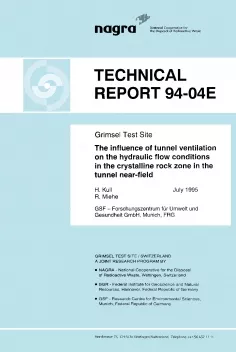
Technical Report NTB 94-04
Grimsel Test SiteThe influence of tunnel ventilation on the hydraulic flow conditions in the crystalline rock zone in the tunnel near-field
Since 1984 different methods have been tested at the Swiss Grimsel Test Site in order to investigate the suitability of crystalline rock with a view to hosting a repository for radioactive wastes. The activities are carried out in cooperation with the Federal Institute for Geoscience and Natural Resources (BGR) and the GSF-Institut für Tieflagerung (GSF/IfT).
Apart from investigating the transport of joint water, the evaluation of the influence of the gas phase on the hydraulic properties of the rock has been one of the major issues of the German/Swiss analyses since 1991. The focal point of the GSF work in this instance is the interpretation of both water flow conditions and the mobility of a gas phase in the so-called desiccation zone in the near-field of the ventilation test tunnel.
The measurement data and results, e.g. volume of water and formation water pressures, mean permeability, relative gas and water permeabilities and capillary pressures, are taken as basic parameters for the calibration of the hydraulic near-field model.
The influence of the tunnel climate on the long-term, large-scale release of water and pressure development is determined by means of site-specific in situ investigations. For this purpose the ambient temperature in an approximately 40 m long tunnel section is increased stepwise under decreased relative air humidity from 12°C to a temperature of 40°C, which is to be expected in future underground repositories at 1000 m depth. The measurement results confirm the assumption that due to the occurrence of moisture gradients, which are to be attributed to the altered climatic conditions, additional water is released. The rock emits more moisture via vaporization than can be replaced by the hydraulic gradient.
In laboratory investigations, the decrease of relative permeability for water attributable to the desaturation of the rock in the near-field of the tunnel is determined on cores, taking the corresponding capillary pressure curves into consideration. These measurements are carried out with capillary pressures of up to 6 MPa. The high capillary pressures which already occur in the event of only slight changes in saturation are equally characteristic for the Grimsel Granodiorite, as is the high degree of residual water saturation. A completely water-saturated core can only be desaturated to about 50 % by high gas injection pressures of more than 4 MPa.
The preferred flow paths and storage cavities within the matrix area are – as can be seen by means of the UV-analysis of prepared thin sections – confined to the micrometer-sized intergranular pore spaces.
The impact and extent of a derivable dual porosity and permeability system for the undisturbed granodiorite (joints/matrix) are investigated with hydraulic packer tests in boreholes. The objective of these so-called constant rate tests – apart from a description of the flow model – is to determine the transmissivities and to describe the boundary conditions of hydraulic flow. Particularly from the pressure interferences between the injection interval and the pressure observation intervals of a total of 32 borehole measurement sections, conclusions can be drawn as to the flow geometries and flow boundaries. For instance, within a radius of about 25 m around the injection interval of borehole BOVE 88.002/1, a hydraulic flow boundary designated as "shear zone" was perceived and the dual permeability system in the matrix areas with a mean permeability of 1E-17 to 1 E-18 m2 was confirmed. Pressure test evaluation was carried out with upto-date calculation programs (such as INTERPRET or WELTEST), which provide for an optimum adaptation of the test data to the test conditions and geometries and their corresponding simulation.
The findings of the in situ and laboratory measurements are taken as basic and calibration parameters for the hydraulic modelling of the flow processes within the area of the ventilation test tunnel. In a hydraulic block model, consisting of 8400 blocks, the potential influences such as anisotropic effects or the hydraulic desaturation versus time of the tunnel near-field, are simulated for an approximately 80·× 80·× 240 m sized rock mass. The 3-D model calculations are carried out with the calculation program ECLIPSE/INTERA, based on a dual flow model and two-phase flow. The model calculations are completed upon incorporation of diffusion processes.
In view of the saturation conditions in the near-field of the tunnel and taking into consideration the Nagra investigation results, the interpretation of the current measurement data permits the conclusion that the water-saturated rock is merely partially desaturated within a very confined area through ventilation and that this process may be considered as being reversible. Seen on a large scale, the partial desaturation of the tunnel vicinity exerts no measurable influence on the hydraulic flow conditions in the rock.
